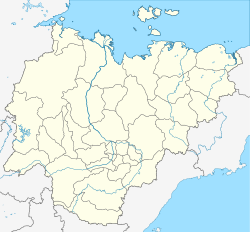Oymyakonsky ulus
Ulus / Rajon
|
||||||||||||||||||||||||||||||||||||||||
The Oymyakonsky District ( Russian Оймяконский улус even Оймяконский район , Oimjakonski rayon; Yakut улууһа Өймөкөөн , Öjmököön uluuha ) is one of 34 Ulusse ( Rajons ) of the Republic of Sakha (Yakutia) in the north of the Russian Federal District Far East . It is located south of the Arctic Circle on the eastern border of the republic to Magadan Oblast and the Khabarovsk region inland. The village of Oymyakon , famous for its cold records, is the administrative seat of a rural community of Ulus.
geography
The Ulus has an area of about 92,200 km², slightly larger than Austria . It includes the headwaters of the Indigirka and its upper tributaries. The landscape has mostly high mountain character . The mountains in the south belong to the Verkhoyansk Mountains , the highest peak of which, Mus Khaya , reaches 2959 m above sea level. To the north of the Ulus, the Indigirka breaks through the Tscherski Mountains . The 2682 m high Tschen rises there . In the south and east, the continental divide between the Arctic and Pacific Oceans forms the boundary of the Ulus.
The vegetation consists of taiga in protected areas and tundra in higher altitudes .
Demographics
The population began to rise earlier than in parts of the republic further northeast, as part of the Kolyma labor camps were located in the area from the 1930s , but then remained relatively constant until around 1990. Due to the emigration that can also be observed in neighboring Ulussen since the end of the Soviet Union, it is now more than half below the value of 1959:
- 1939 - 3,560
- 1959 - 22,947
- 1970 - 21,636
- 1989 - 32,320
- 2002 - 14,670
- 2010 - 10,109
The population consists, with an increasing tendency, of members of indigenous ethnic groups , which is still less than in the surrounding Ulussen. Among the members of ethnic groups who immigrated from the European part, the proportion of Ukrainians is relatively high compared to the republic .
| Ethnicity | 2002 | 2010 | |
|---|---|---|---|
| % | people | % | |
| Yakuts | 23 | 2932 | 29.18 |
| Ewenen | 2 | 429 | 4.27 |
| Russians | 57 | 5291 | 52.65 |
| Ukrainians | 10 | 623 | 6.20 |
Communities
The ulus consists of 2 municipal formations of the urban type and 5 village municipal formations, referred to as nasleg in the Sakha Republic . At the end of the 20th century, the Ulus had seven town-like community formations; due to the population decline since 1990, five of them were dissolved in 2002 and 2007.
The names are listed in the following table first in transliteration and after the dash in the original Cyrillic spelling:
| Type | Yakut name of the municipality |
Russian name of the municipality |
Population 2007 (2010) |
Yakut name of the parish seat |
Russian name of the parish seat |
| urban | Uus N'ara - Уус Ньара | Ust'-Nera / Усть-Нера | 8,469 | Urban-type settlement , administrative seat of the Ulus | |
| urban | Aartyk - Артык | Artyk / Артык | 722 | ||
| rural | Ikkis Boroğon - Иккис Бороҕон | Borogon I - Борогон 1-ый | 1,498 | Tomtor - Томтор | Tomtor - Томтор |
| rural | Mangnajgy Boroğon - Маҥнайгы Бороҕон | Borogon II - Борогон 2-ой | 906 | Öjmököön - Өймөкөөн | Ojmjakon - Оймякон |
| rural | Sordongnooch - Сордоҥноох | Sordonoch - Сордоннох | 384 | Tomtor - Томтор | Tomtor - Томтор |
| rural | Törüt - Төрүт | Terjut - Терют | 409 | Törüt - Төрүт | Terjut - Терют |
| rural | Üčügenj - Үчүгэй | Jučjugej - Ючюгей | 323 | Üčügenj - Үчүгэй | Jučjugej - Ючюгей |
traffic
The Ulus is crossed in a west-east direction by the trunk road R504 Kolyma from Nizhny Bestjach near Jakutsk to Magadan , on which Ust-Nera is also located.
Web links
- Oimjakonski ulus in the official information portal of the Republic of Sakha (Yakutia), in Russian
Individual evidence
- ↑ Itogi Vserossijskoj perepisi naselenija 2010 goda. Tom 1. Čislennostʹ i razmeščenie naselenija (Results of the All-Russian Census 2010. Volume 1. Number and distribution of the population). Tables 5 , pp. 12-209; 11 , pp. 312–979 (download from the website of the Federal Service for State Statistics of the Russian Federation)
- ^ Results of the 2010 census for the Republic of Sakha (Yakutia) on the Sachastat (Yakutiyastat) website , Volume 4, Table 2


